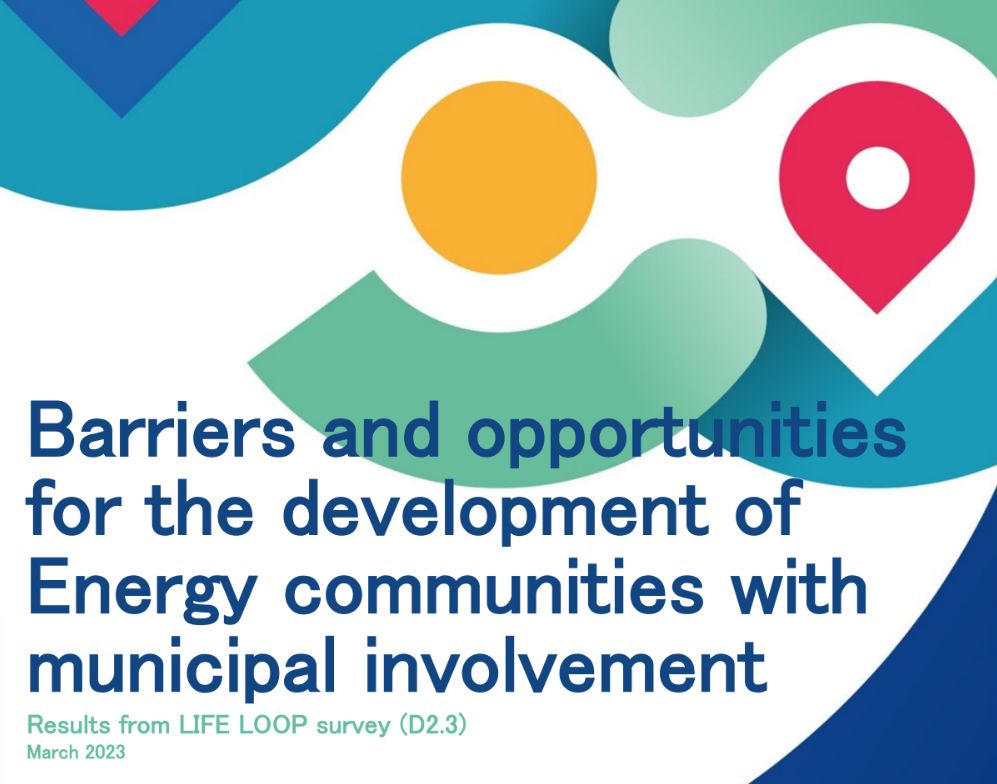Citizens and local authorities: converging views on local renewable energy projects?
Insights from the LIFE LOOP barriers and opportunities report
A brandnew report on cities and civil society’s perception of energy community has just been released. It identifies the available capital and presents barriers and opportunities for the collaborative development of energy communities with municipal involvement. Those findings are the result of a survey by REScoop.eu to better grasp the realities regarding collaboration between citizen energy cooperatives and local municipalities in different parts of Europe. The survey, carried out at the beginning of the year in the framework of the LIFE LOOP project, targeted people involved in energy cooperatives or communities as well as local municipalities.
About 63% of the respondents are engaged in citizens organisations, while the rest (37%) represent local municipalities. 71.5% of the respondents had already been involved in a specific community energy project, while the remaining 28.5% were not. Overall, they represent 16 EU and 2 non-EU countries.

Key takeaways for city-citizen partnerships
- A local detailed assessment should be done to reveal the reasons that may discourage municipalities from collaborating with citizens in community energy projects and vice versa.
- Awareness-raising is still very much needed, along with the creation of networks and platforms to share experience and build evidence about the benefits of energy communities with municipal involvement and support.
- Targeted training and capacity-building for local municipalities are needed to participate in energy communities, not only around technical skills related to financial and legal issues, but also competences on communication, trust and relationship-building.
- Specific policies and concrete incentives for municipalities are needed, both at national and European levels, to support the development of energy communities with collaboration between local authorities and citizens’ initiatives.
- Member States should fully recognize the role of energy communities and include funds in national and regional budgets that can be used by regional and local authorities to safeguard an active role of and support from municipalities in energy communities.
- Monitoring the progress is imperative to the development of energy communities with city-citizen participation.
Shifting attitudes and adjusting processes to trigger collective action
The report provides some preliminary recommendations to the key players: local authorities wishing to get involved in energy communities and to citizen-driven energy initiatives wanting to collaborate with their local municipalities.
To flourish energy communities need to build partnerships and engage a variety of local stakeholders. Energy communities are built by people for the people. Therefore, their establishment requires several social pre-conditions, including trust. Yet, the survey respondents think that levels of mutual trust are not always sufficient and the benefits of energy communities are not equally recognised by the main potential partners of citizen-driven initiatives, that is, local authorities, NGOs and SMEs.
Moreover, the low level of political support and lack of political vision regarding community energy initiatives and projects are highlighted across European counties. The respondents also stress the absence of an open and direct dialogue between energy communities and top-level officers of the respective energy ministries. A case should be made for the development of specific policies, both at the national and European levels to remove existing counterincentives and, ultimately support citizen-driven energy communities with municipal involvement.
Finally, about 39% of survey participants strongly reject the statement about the compatibility of public procurement policies and community energy projects. In addition, about 31% of the participants claim that municipal procurement rules are incompatible with community energy projects. At the same time, about one-fifth of the respondents (of both related survey questions) either does not have an opinion or knowledge on the matter.
As we strive for a decentralised, democratic, and renewable energy future, it’s becoming increasingly clear that citizen initiatives and local municipalities face unique challenges and opportunities. Our analysis reveals that by working together to develop and operate energy communities, they can leverage their respective strengths to overcome obstacles and achieve their shared goal of local ownership of power.
Through collaboration, citizen initiatives and local municipalities can tap into their complementarity, lifting each other up when needed. By coming together, they can harness the power of local ownership and make significant strides towards a more sustainable future.
BACKGROUND
The transition to clean and sustainable energy sources must happen in a democratic and socially just way. This includes efforts and investments in local renewable energy projects made by local citizens in collaboration with municipalities and small and medium enterprises (SMEs). Fostering this cooperation is the mission of the LIFE LOOP project.
Community energy projects are an effective way to promote local resilience and participation in collective decision-making processes. When citizens and municipalities work together, they have access to a broad range of resources, including capital, networks, and skills. Moreover, municipalities can mobilize local communities in various ways, access public funds, and develop supportive policies and strategies. However, despite the growing popularity of the concept of energy communities across Europe, many cities, especially in Southeast and landlocked countries in Central Europe, still struggle to move from ideas to action. Many local municipalities have committed to energy or climate goals, but reaching them can be challenging.

